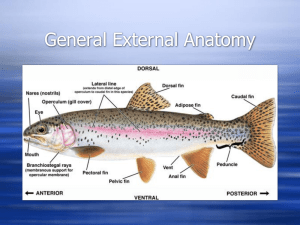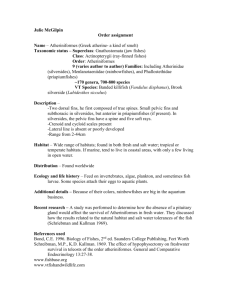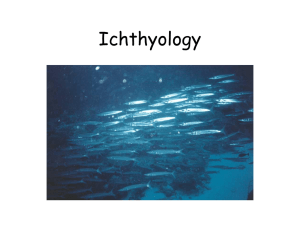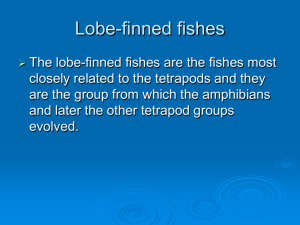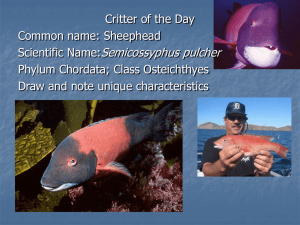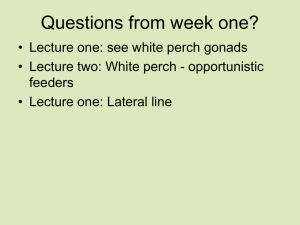Marine Vertebrates: Lecture 3
advertisement
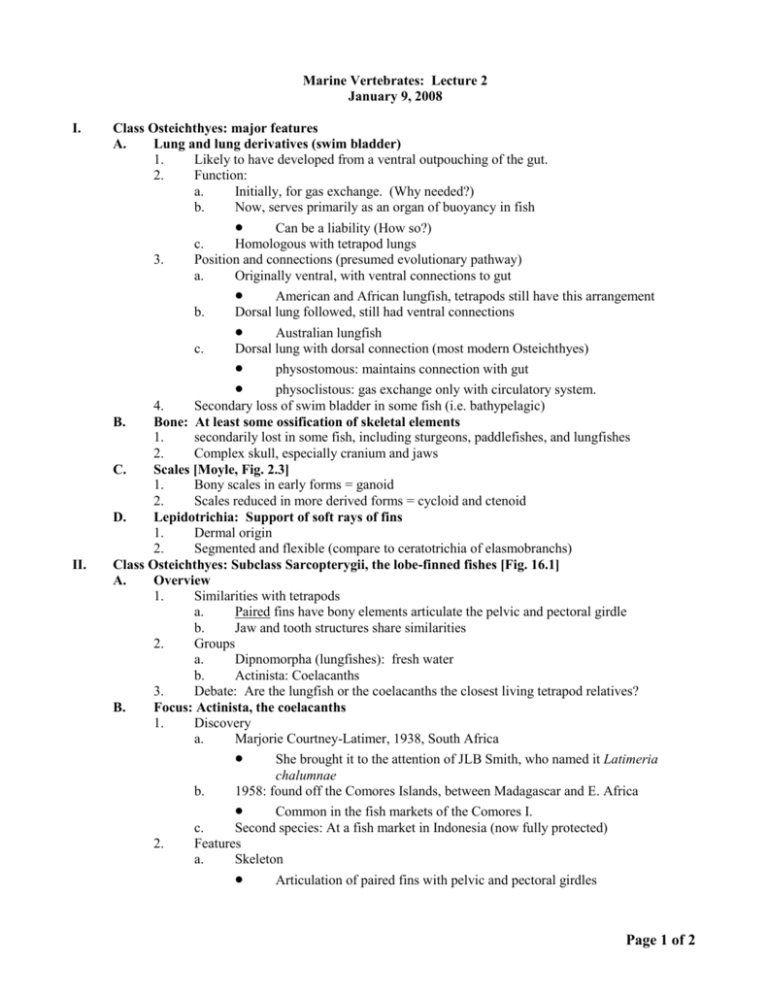
Marine Vertebrates: Lecture 2 January 9, 2008 I. Class Osteichthyes: major features A. Lung and lung derivatives (swim bladder) 1. Likely to have developed from a ventral outpouching of the gut. 2. Function: a. Initially, for gas exchange. (Why needed?) b. Now, serves primarily as an organ of buoyancy in fish Can be a liability (How so?) c. Homologous with tetrapod lungs 3. Position and connections (presumed evolutionary pathway) a. Originally ventral, with ventral connections to gut American and African lungfish, tetrapods still have this arrangement b. Dorsal lung followed, still had ventral connections Australian lungfish Dorsal lung with dorsal connection (most modern Osteichthyes) physostomous: maintains connection with gut physoclistous: gas exchange only with circulatory system. 4. Secondary loss of swim bladder in some fish (i.e. bathypelagic) B. Bone: At least some ossification of skeletal elements 1. secondarily lost in some fish, including sturgeons, paddlefishes, and lungfishes 2. Complex skull, especially cranium and jaws C. Scales [Moyle, Fig. 2.3] 1. Bony scales in early forms = ganoid 2. Scales reduced in more derived forms = cycloid and ctenoid D. Lepidotrichia: Support of soft rays of fins 1. Dermal origin 2. Segmented and flexible (compare to ceratotrichia of elasmobranchs) Class Osteichthyes: Subclass Sarcopterygii, the lobe-finned fishes [Fig. 16.1] A. Overview 1. Similarities with tetrapods a. Paired fins have bony elements articulate the pelvic and pectoral girdle b. Jaw and tooth structures share similarities 2. Groups a. Dipnomorpha (lungfishes): fresh water b. Actinista: Coelacanths 3. Debate: Are the lungfish or the coelacanths the closest living tetrapod relatives? B. Focus: Actinista, the coelacanths 1. Discovery a. Marjorie Courtney-Latimer, 1938, South Africa She brought it to the attention of JLB Smith, who named it Latimeria chalumnae b. 1958: found off the Comores Islands, between Madagascar and E. Africa Common in the fish markets of the Comores I. c. Second species: At a fish market in Indonesia (now fully protected) 2. Features a. Skeleton Articulation of paired fins with pelvic and pectoral girdles c. II. Page 1 of 2 Both bone and cartilage, but the vertebral column is shark-like, a notochord supported by cartilage 3. Fin spines: cartilaginous, hollow Scales are “cosmoid”, with bone Skull and jaw are partly ossified Intracranial joint: unique to this group (allows flexion of head while feeding!) b. Osmotic regulation Nearly isotonic with seawater; maintained by high concentration of urea Similar to??? c. Swim bladder: Fat filled; helps it maintain neutral buoyancy No problems associated with air expansion. d. Reproduction: ovoviviparous Behavior (underwater observations) a. Divers observed “lie-in-wait” predation consistent with body form and fin placement Feeds on bottom fishes, including sharks b. Principal swimming organs: its paired fins Extraordinarily mobile, can be rotated forward by 200 degrees, backward by 100 degrees (close to a completely circular range of motion!) c. Uses a “rotating, sculling action” in an alternating pattern like a tetrapod. Does not use its fins to walk on the bottom Class Osteichthyes: Subclass Actinopterygii: the ray-finned fishes III. Infraclass Chondrostei: Focus on sturgeon A. Anadromous or wholly fresh water, focus is for understanding evolutionary pathway B. Features (asterisks show commonalities with Chondrichthyes) 1. Five rows of bony* scales (ganoid or “rhomboid”) a. Secondarily cartilaginous skeleton (but derived independently from Chondrichthyes) 2. Some have spiracles; at least have spiracle remnants* 3. Spiral valve present (not in more derived Actinopterygii)* 4. Heterocercal tail* 5. No teeth. So how does it feed? 6. How does it find food? What does it eat? 7. Long, slow growth, but also high fecundity (mix of r and K strategies) 8. Roe = caviar a. All sturgeon species threatened in at least part of their range. Why? IV. Infraclass Teleostei A. Derived characters 1. Bone in scales is highly reduced 2. No spiracles or remnants of spiracles 3. Tail is homocercal 4. Specific skeletal aspects are shared (details beyond the scope of this course) B. Overall diversity 42 orders, 431 families, 23,681 species… References Bond CE, 1996. Biology of Fishes. Harcourt Brace College Publishers: Fort Worth, 750 pages. Moyle PB, Cech JJ Jr.,2003. Fishes: An Introduction to Ichthyology, 5th edition. Prentice Hall: New Jersey, 726 pages. Thomson KS, 1991. Living Fossil: The Story of the Coelacanth. WW Norton and Co.: New York, 252 pages. Page 2 of 2
